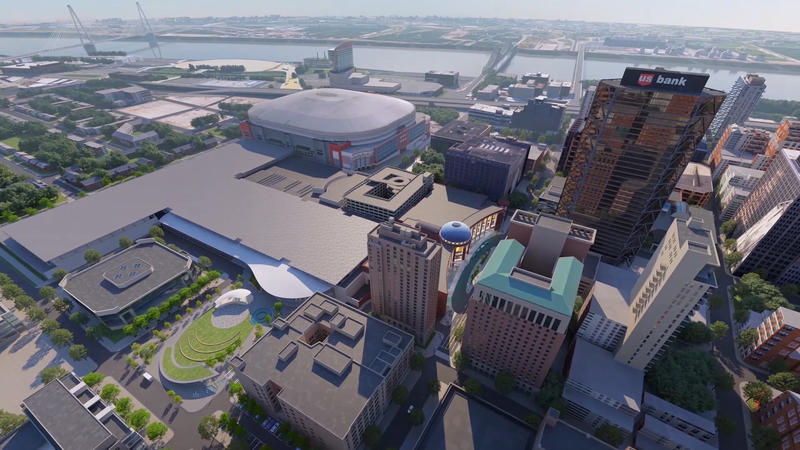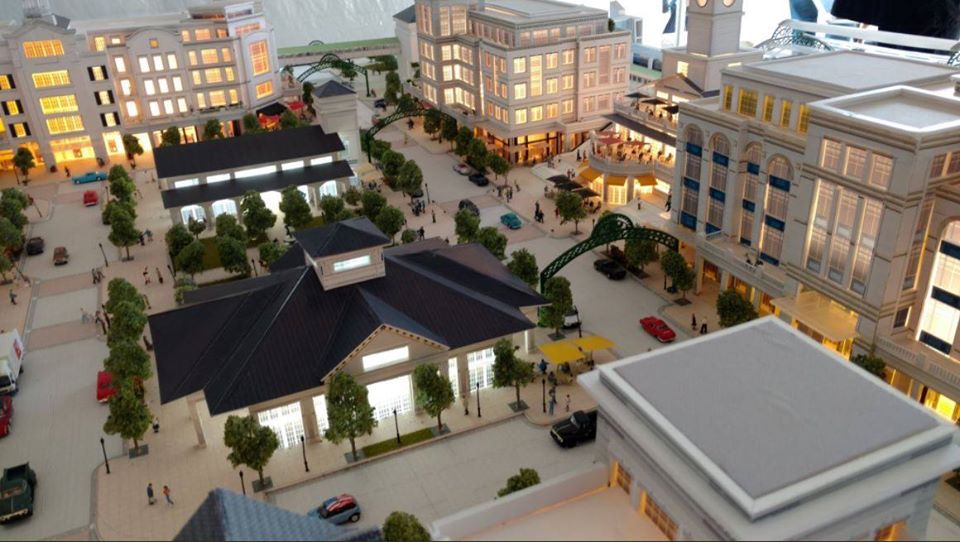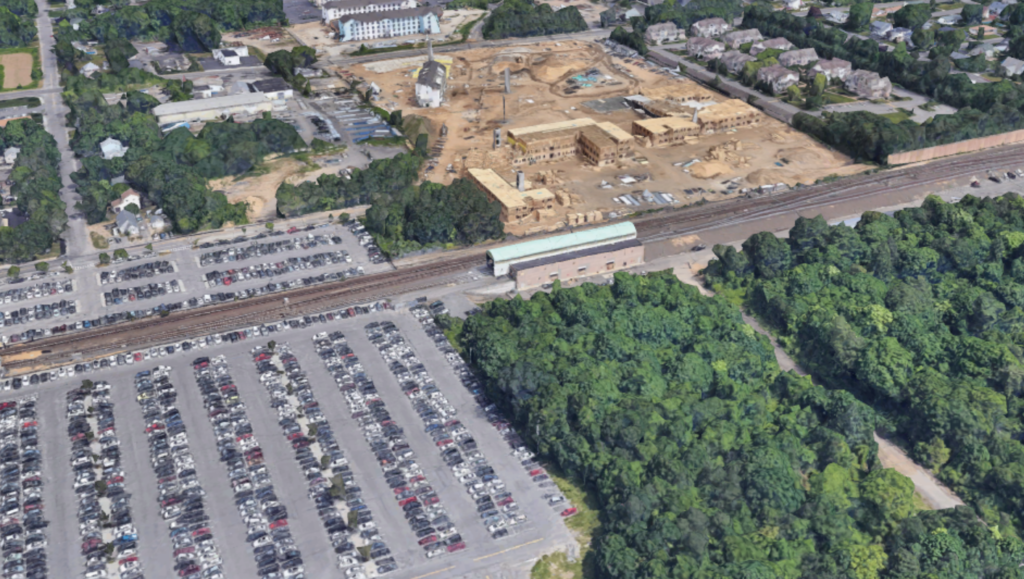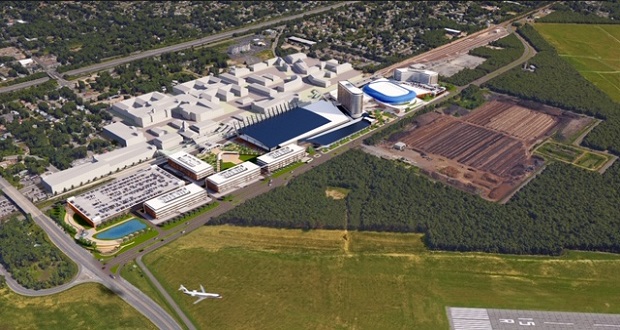The following was exclusively published by The Foggiest Idea on November 18, 2019. Interested in supporting The Foggiest Idea’s award-winning reporting and analysis? Click here.
Boosters claim if we build a big new venue near the Ronkonkoma Hub, people will come and revenues will rise, but skeptics doubt the market can make this deal worthwhile in the long run.
By Richard Murdocco
Between the Long Island MacArthur Airport and the Long Island Rail Road’s Ronkonkoma station lie 40 acres of parking lots. They sprawl just south of the Ronkonkoma Hub, one of the most important mixed-use projects in the region thanks to its ideally accessible location to trains, planes and automobiles.
During Steve Levy’s tenure as Suffolk County Executive, this site was slated for solar carports that would span the 3,000 space lot. But Steve Bellone, Levy’s Democratic successor, pulled the plug on that idea, a decision which ultimately cost the County around $13.5 million when a judge ruled that Suffolk had intentionally breached the contract with the project’s expected partner.
With the solar project scrapped, Suffolk County policymakers scrambled to see what could be built in its place and they decided to solicit Request for Qualifications from developers.
After a lengthy, less-than ideal selection process, the county landed on a development partner calling for a $1.1 billion project that includes a sports arena, offices, medical facilities, and a convention center. Bellone is hoping that Suffolk will get a much-needed economic shot in the arm but the County may come up short. In other cities across the country, arenas and convention centers have both become economic losers.
Initially, the proposal was spear-headed by the giant Chicago-based commercial real estate developer Jones Lang LaSalle, billionaire investment banker Ray Bartoszek, and Woodbury-based Cameron Engineering.
Newsday reported in September 2018 that Bartoszek’s group had cited a defunct Seattle sports arena project as part of their pitch to Suffolk officials, raising questions about their qualifications to shepherd such a large effort on Long Island. Bartoszek’s Connecticut-based company, RLB Holdings, had hoped to bring an NHL expansion franchise to Seattle but the deal ended up on thin ice. After Bartosznek dropped out of the Ronkonkoma proposal, Islanders/Rangers star Pat LaFontaine stepped in to try to drum up interest in landing a minor league hockey team for the as-yet-to-be built venue here.
Critics (including this author) have rightly argued that placing yet another sports arena on Long Island basically ignores the fact that the market for this kind of venue is already oversaturated in our region. Proponents tell The Foggiest Idea that Suffolk County has a compelling argument for a convention center and that a new sports venue is clearly needed here.
According to Kristen Jarnagin, the head of Discover Long Island, Nassau/Suffolk’s official tourism promotion agency, this kind of space is long overdue because the dynamics of the regional economy have shifted.
“Historically, we’ve relied on our growing population to sustain rising costs,” Jarnagin told TFI, referring to pressure on local governments to balance their budgets. “We’re not seeing that growth anymore. As a region, what are we going to do to sustain these costs and generate revenue? That’s where a convention center comes in.”
Jarnagin has been a long-term proponent of using convention centers as a mechanism to jumpstart growth. To her, Ronkonkoma’s connectivity is key for a local venue’s success.
“I absolutely feel that Ronkonkoma is the primary place where a convention center would be viable,” she said, noting that other U.S. cities have built these kinds of centers in easily accessible areas to more readily attract outside dollars during the week, rather than rely on weekend travelers to come into the area and spend their money. “The reason why Ronkonkoma works is because a venue would serve as a sustainable driver to increase airlift at MacArthur Airport,” she explained. “Meeting planners want easy access, and Ronkonkoma is equidistant to both Manhattan and the Hamptons.”
So why not just book big events in New York City? Jarnagin was ready with the answer.
“A lot of people are simply priced out of New York City,” she explained, “and they’re already at capacity.” She noted that the city is already looking at expanding its convention capacity in the coming years. “We are not competing,” she said, “but serving as a second alternative market.”
To Jarnagin, adding new space in Suffolk County makes sense because she considers Nassau Coliseum as more of an exhibition venue than as a suitable convention center.
In addition to citing the Coliseum’s shortcomings, she believes that the Suffolk proposal could serve as a “critical pillar to economic development” because it could bring in outside revenue without driving up residential costs and offer the opportunity to “raise the profile of Long Island’s intellectual capital,” as she put it.
Discover Long Island, which has been front and center in championing the convention center cause, isn’t alone in pushing for this use on the parking lot site.
“We believe a new convention center would spur economic growth in concert with the other significant economic development opportunities in that surrounding area,” the Long Island Association, a business advocacy group, told TFI, essentially repeating language the L.I.A. has been using to convey its 2019 strategic priorities.
Not everyone in the region is as steadfast in backing this kind of project as Discover Long Island and the L.I.A. are. When asked by TFI to share its input, the Town of Islip, the municipality where this property sits, sounded rather less than gung-ho about the idea.
“Suffolk County’s significant and conceptual mixed-use development, located in the Town of Islip between the LIRR and Long Island MacArthur Airport, will likely require a State Environmental Quality Review positive declaration. This results in the project sponsor’s preparation of an environmental impact statement,” a spokesperson for the Town of Islip told TFI. “The Town maintains, in all instances, an unbiased perspective on all development projects as they progress through an environmental review.”
Pressed for more comment, the Islip spokesperson demurred. The neighboring Town of Brookhaven, the site of the Ronkonkoma hub, was more forthcoming but also more skeptical.
“Conceptually, it’s interesting, but I’d certainly need more details before making a reasonable judgment,” said Brookhaven Town Supervisor Edward Romaine, adding that one issue is the region’s geography. “A lot of people don’t want to come to a dead-end island,” he said. “Convention centers elsewhere have succeeded because they are easily accessible in all directions.”
Romaine, who has a lengthy tenure in public service and just handedly won another term, isn’t easily moved by developmental buzzwords or trends. “I’d like to see evidence that a convention center would be successful,” he said.
That concern may well be justified.
“Virtually every convention center in the country loses money,” said University of Chicago economist Allen Sanderson in a May 2016 article by the St. Louis Post-Dispatch on the topic, as St. Louis was considering spending $175 million on expanding the America’s Center Convention Complex. According to the paper, the city and the county currently pay $12 million annually on the debt accrued after building the Dome addition to the convention center, with an additional $12 million match contributed by the State of Missouri.
“And just because you have a new one doesn’t mean Alcoholics Anonymous is going to meet more often,” Sanderson added. “The convention business is pretty cutthroat. It’s hard to make any money.”
The expansion deliberation is still ongoing in St. Louis, as the City Council recently voted to formally allocate money to the project. After the vote, not every official was pleased. “Can you smell it? Can you?” St. Louis County Council Presiding Officer Ernie Trakas told St. Louis Public Radio. “Because I can smell it up here, and it stinks.”

A rendering of a proposal currently under consideration that would upgrade the America’s Center Convention Center in downtown St. Louis. (Photo Credit: Explore St. Louis)
In 2004, City Journal explored the topic at length, citing multi-million dollar examples in Boston, San Francisco, Omaha, Pittsburgh, and Baltimore, where experts noted that the increase in convention space has “vastly outpaced the growth of the convention industry and often failed to generate the kind of economic activity predicted by boosters.”
“Rather than energizing local economies,” the New York City-based publication noted, “in fact, some convention centers are emerging as a drag on civic finances, requiring taxpayer operating subsidies on top of their huge, publicly financed construction costs.”
Writing in 2012, CityLab’s Amanda Erickson found that “there aren’t really enough conventions to go around. The actual number of conventions hosted in the U.S. has fallen over the last decade. Attendance at the 200 largest conventions peaked at about 5 million in the mid-1990s and has fallen steadily since then.
“Major commercial centers, Chicago, New York, Atlanta, and New Orleans, have all seen significant recent loss in convention activity, even as they expand their convention centers,” Erickson wrote. “In Las Vegas and Orlando — the two up-and-comers in the convention space — recent expansions have done little to grow the number of visitors per year.” As Erickson put it, if conference titans like Chicago and New Orleans are struggling, what chance does a secondary market like Buffalo have? Here Suffolk County faces the same question.
Regardless of other municipality’s woes and the mounting data, Bellone is eager to get things going on Long Island. Fresh off a big reelection win, this suburban county executive has ambitions that could take him one day beyond Hauppauge to Albany.
“To me, this was a clear mandate from the public,” Bellone said in an interview with Newsday, adding that he saw his 55%-to-43% victory margin as a clear message that the public supports his work. And so Bellone’s deputies are moving forward.
“We’re definitely still working,” Natalie Wright, the county’s acting commissioner of the Department of Economic Development and Planning since July 2019, told TFI. “A convention center is still a component and focal point of the development.”
Theresa Ward, Wright’s predecessor, initially helped lay the groundwork for the arena/convention center concept. Ward was one of four unelected county economic development officials who formally selected JLL’s proposal. She left in July for a new gig in New York City, giving Wright the chance to step in. Another official who approved the selection, Louis Bekofsky, the deputy commissioner of Economic Development and Planning Department, had departed for the private sector in October 2018.
Although the arena capacity has been cut in half from its initial 17,500-seat amount, Wright told TFI that the convention center concept has remained fairly consistent.
“One evolution we’ve worked on with Discover LI and JLL is making it for multi-purpose events,” said Wright, adding that the venue would be flexible enough to host an array of events including indoor sporting events and tournaments, such as E-gaming and cheerleading competitions.
Asked about the diminishing returns that venues in other cities have had, Wright expressed her confidence that Ronkonkoma’s proximity to the New York City market would work in its favor.
“We do have the two transportation assets, MacArthur Airport and the LIRR, giving us a favorable mix,” said Wright, saying that meeting planners could have their people fly or ride right in and stay nearby.
Competing with other venues didn’t deter her.
“We certainty would work to schedule events to its maximum capacity,” said Wright, adding that the convention center in Ronkonkoma would try to book large conventions and smaller, more community-focused events. “I think there is market opportunity at all levels,” she said.
David Calone, who served as the chairman of the Suffolk County Planning Commission from 2008 to 2015, agrees with Wright.
“There isn’t really a true convention center on Long Island,” Calone told TFI. “Long Island is perfectly situated to attract this kind of business with its proximity to New York City and its beaches, wineries, and convenient airports. A modern convention center would be an economic game changer for our region.”
So who would take responsibility for booking the new venue?
“We have not made a decision as to who would manage the event scheduling at this point in time,” she said. As for the financing, that question remains undecided as well. “This would be a public/private partnership, and we have not worked out the ratios,” she explained.
Wright expects JLL to submit their due diligence materials, including harder looks at the market, and what she calls “the gathering of intimate details for a fully-fleshed conceptual plan” sometime in early 2020. Then the county anticipates having a third party conduct a peer review of the proposal, which would ultimately require final approval by the Suffolk County Legislature. “We still have a ways to go,” she said.
Meanwhile near the site slated for the County’s convention/arena project work continues on the Ronkonkoma Hub by TRITEC, which is developing 1,450 residential units, 195,000 square feet of retail, 360,000 square feet of office/medical space, and a hotel. The Setauket-based builder didn’t respond to repeated requests for comment.
But other sources in the development industry shared their concerns with TFI about the County’s concept, including the proposed center’s financial viability and whether taxpayers will be left on the fiscal hook. One well-connected insider even went so far to call it a “disaster” for the region if the venue fails.

A model of TRITEC’s Ronkonkoma Hub, on display at the project’s celebratory groundbreaking in November 2017. (Photo Credit: Richard Murdocco)
DuWayne Gregory (D-Wyandanch), the presiding officer of the Suffolk County Legislature, thinks such a meeting space could be an asset if it’s promoted correctly by the County.
“My bit of advice has always been to get as much of the community involved as possible,” said Gregory, noting that similar convention centers are generally located in major metropolitan areas. “Anecdotally, people seem to be excited about it here in Suffolk, and there isn’t a huge amount of hotels or one central gathering place for business folks.”
Gregory cited the difficulty that his wife, Erica Chase-Gregory, the Regional Director of the Small Business Development Center at SUNY Farmingdale, had trying to find a suitable venue for an upcoming 250-person conference her agency was hosting. “If she went through it,” explained the Legislator, “I’m sure others have as well.”
But Gregory has questions about the venue’s fiscal longevity. “You have to have someone very experienced in marketing the center that would be able to attract people,” he said. “I think there is still very much a big question mark about its sustainability for the region.”
Suffolk County Legislator Tom Cilmi (R-Bay Shore), the Legislature’s minority leader, represents the area where the new convention center would be built. He took a noncommittal approach.
“We have not seen a final proposal yet from the master developer,” Cilmi told TFI. “Until we see that—and until we see the breadth of what the proposal is and put it into context—it’s hard to say.”
Cilmi says he supports the idea, but he questions the impact such a space would have locally and how it would adapt to the ever-changing business dynamics.
“I think a convention center at the Hub would be an excellent addition to the area,” said Cilmi. “But we’d have to see what the traffic impacts are going to be, and whether or not it can stand on its own.”
He noted how employers are increasingly allowing their staff to work from home and that could affect the need for these kinds of social settings.
“Whether or not a convention center is in demand, based purely on how business does business, is a valid question,” Cilmi said.
To Cilmi, comparing an area like Chicago with Ronkonkoma is tough to do.
“You can almost say it’s apples and oranges,” observed the Long Island legislator. “The options for business to gather in a place like Chicago are obviously many, but the options here, particularly in Suffolk, are not nearly as many.”
And so, as it seems to go with everything related to development on Long Island, the questions outnumber the answers. But one thing is certain: freeing up that parking lot has already put the County in a $13.5 million hole—and that’s before the convention center even gets off the ground.
Richard Murdocco is an award-winning columnist and adjunct professor in Stony Brook University’s public policy graduate program. He regularly writes and speaks about Long Island’s real estate development issues. Follow him on Twitter @thefoggiestidea. You can email Murdocco at Rich@TheFoggiestIdea.org.













